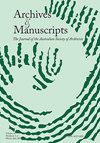Activist archives: youth culture and the political past in Indonesia
IF 1.3
Q2 INFORMATION SCIENCE & LIBRARY SCIENCE
引用次数: 0
Abstract
Almost two decades after the fall of the Suharto regime in May 1998, we still know very little about the student movement that was the driving force behind Indonesia’s turn to democracy. In the post-Suharto era, the student movement lost the limelight to other actors better equipped for the game of politics, and thus moved ever deeper into the realm of collective memory as a feverish episode in history, aligned with the longer history of pemuda (youth) activism in Indonesia. Yet, as Doreen Lee persuasively argues in Activist Archives, it is from the edges of history that “pemuda fever” continues to “infuse the present with urgency and legitimacy” (p. 3), animating a “youthful culture of democracy” that firmly established radical styles and ideas within the political and cultural landscape of Jakarta. Remedying the dearth of literature on post-New Order student activism, Activist Archives offers a sophisticated ethnography of “Generation 98”, ingeniously structured around key tropes of the “material and ideational spaces” that student activists inhabit. With a keen eye for detail and paradox, Lee delves deep into the micropolitics of these spaces, starting with the “Archive”. She shows how activists’ feverish “drive to document, consign, and assemble signs of pemuda nationalism” (p. 11) served as an “authenticating practice” to compete with state discourse, which was, however, complicated by the concurrent need for secrecy, epitomized by the tacit rule: “Burn after reading”. By highlighting the social life behind the documentation, Lee uncovers significant findings that many other researchers might have overlooked. A charming example is a scene reconstructed from scribbles found on the back of official statements used during the 1997 subversion trials; it shows how two activists, waiting for their turn to testify, exchanged insolent jokes, conveying “the undercurrent of youthful nonchalance and puerile lightheartedness even during the gravity of the subversion trial” (p. 55). Youthfulness also pervades the chapters on “Street” and “Style”, which show how the performativity of protest and the carefully cultivated pemuda look helped to make subversive symbols of the left trendy and less threatening, thus creating “a new model of citizenship for Indonesian youth by making political participation desirable and accessible” (p. 91). In an engaging section on the production and circulation of protest T-shirts, Lee further illustrates激进分子档案:印尼的青年文化与政治历史
1998年5月苏哈托(Suharto)政权倒台近20年后,我们对推动印尼走向民主的学生运动仍然知之甚少。在后苏哈托时代,学生运动失去了其他更擅长政治游戏的演员的关注,因此作为一段历史上的狂热插曲深入到集体记忆的领域,与印尼更悠久的pemuda(青年)激进主义历史相一致。然而,正如多琳·李(Doreen Lee)在《活动家档案》(Activist Archives)中令人信服地指出的那样,正是在历史的边缘,“pemuda热”继续“为当下注入紧迫性和合法性”(第3页),使“年轻的民主文化”活跃起来,在雅加达的政治和文化景观中坚定地确立了激进的风格和思想。为了弥补关于后新秩序学生运动的文献匮乏,《活动家档案》提供了一本关于“98一代”的复杂人种志,巧妙地围绕着学生运动者所居住的“物质和思想空间”的关键比喻。李对细节和悖论有着敏锐的眼光,从“档案”开始,深入研究了这些空间的微观政治。她展示了激进分子狂热的“记录、委托和收集pemuda民族主义标志的动力”(第11页)是如何成为一种与国家话语竞争的“验证实践”的,然而,同时需要保密的情况使这种做法变得复杂,这体现在“阅后即焚”的默认规则上。通过强调文件背后的社会生活,李揭示了许多其他研究人员可能忽视的重要发现。一个迷人的例子是根据1997年颠覆审判期间使用的官方声明背面的涂鸦重建的场景;它展示了两名积极分子如何在等待轮到他们作证时,互相开玩笑,表达了“即使在颠覆审判的严重性中,年轻人的冷漠和幼稚的无忧无虑的暗流”(第55页)。关于“街头”和“风格”的章节也充满了青春气息,这些章节显示了抗议的表演和精心培养的pemuda外观如何有助于使左派的颠覆性符号变得时髦和不那么具有威胁性,从而“通过使政治参与成为可取的和可获得的,为印度尼西亚青年创造了一种新的公民模式”(第91页)。在关于抗议t恤的生产和流通的引人入胜的章节中,李进一步说明了这一点
本文章由计算机程序翻译,如有差异,请以英文原文为准。
求助全文
约1分钟内获得全文
求助全文

 求助内容:
求助内容: 应助结果提醒方式:
应助结果提醒方式:


